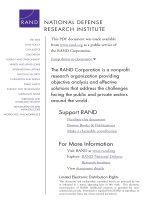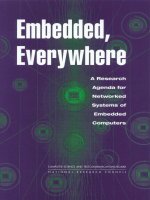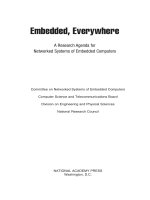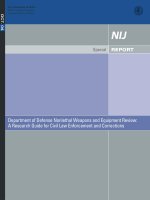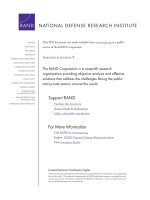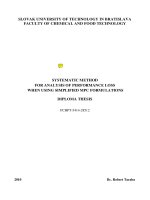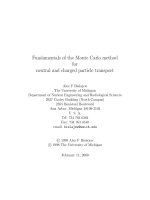Research method for construction 2008
Bạn đang xem bản rút gọn của tài liệu. Xem và tải ngay bản đầy đủ của tài liệu tại đây (1.38 MB, 322 trang )
Research Methods for Construction
Copy edited by Sharon
FELLOWS: “fellows_c000” — 2008/5/21 — 14:29 — page i — #1
Copy edited by Sharon
FELLOWS: “fellows_c000” — 2008/5/21 — 14:29 — page ii — #2
Research Methods
for Construction
Third Edition
Richard Fellows
Department of Real Estate and Construction
The University of Hong Kong
and
Anita Liu
Department of Civil and Building Engineering
Loughborough University
Copy edited by Sharon
FELLOWS: “fellows_c000” — 2008/5/21 — 14:29 — page iii — #3
This edition first published 2008
© 2008 by Blackwell Publishing Ltd
Blackwell Publishing was acquired by John Wiley & Sons in February 2007. Blackwell’s
publishing programme has been merged with Wiley’s global Scientific, Technical, and Medical
business to form Wiley-Blackwell.
Registered office
John Wiley & Sons Ltd, The Atrium, Southern Gate, Chichester, West Sussex, PO19 8SQ,
United Kingdom
350 Main Street, Malden, MA 02148-5020, USA
Editorial office
9600 Garsington Road, Oxford, OX4 2DQ, United Kingdom
For details of our global editorial offices, for customer services and for information about how
to apply for permission to reuse the copyright material in this book please see our website at
www.wiley.com/wiley-blackwell.
The right of the author to be identified as the author of this work has been asserted in
accordance with the Copyright, Designs and Patents Act 1988.
All rights reserved. No part of this publication may be reproduced, stored in a retrieval system,
or transmitted, in any form or by any means, electronic, mechanical, photocopying, recording or
otherwise, except as permitted by the UK Copyright, Designs and Patents Act 1988, without the
prior permission of the publisher.
Wiley also publishes its books in a variety of electronic formats. Some content that appears in
print may not be available in electronic books.
Designations used by companies to distinguish their products are often claimed as trademarks.
All brand names and product names used in this book are trade names, service marks,
trademarks or registered trademarks of their respective owners. The publisher is not associated
with any product or vendor mentioned in this book. This publication is designed to provide
accurate and authoritative information in regard to the subject matter covered. It is sold on the
understanding that the publisher is not engaged in rendering professional services. If
professional advice or other expert assistance is required, the services of a competent
professional should be sought.
Library of Congress Cataloging-in-Publication Data
Fellows, Richard, 1948Research methods for construction / Richard Fellows and Anita Liu. – 3rd ed.
p. cm.
Includes bibliographical references and index.
ISBN-13: 978-1-4051-7790-0 (pbk. : alk. paper)
ISBN-10: 1-4051-7790-X (pbk. : alk. paper) 1. Building–Research–Methodology. I. Liu,
Anita. II. Title.
TH213.5.F45 2008
624.072–dc22
2008002534
A catalogue record for this title is available from the British Library
Set in 10/13pt Palatino by Newgen Imaging Systems (P) Ltd, Chennai, India
Printed in Singapore by Utopia Press Pte Ltd
1
2008
Copy edited by Sharon
FELLOWS: “fellows_c000” — 2008/5/21 — 14:29 — page iv — #4
Contents
Preface to Third Edition
Preface to Second Edition
Part 1 Producing a Proposal
viii
x
1
1
Introduction
The concept of research
Classifications of research
Theories and paradigms
Research styles
Quantitative and qualitative approaches
Where to begin
Summary
References
3
3
7
12
20
26
30
32
32
2
Topic for Study
Selection of a topic
Writing the proposal
Summary
References
35
35
42
50
50
Part 2 Executing the Research
51
Initial Research
The research process
Initial search
Assembling the theoretical framework
Philosophy and methodology
Theoretical models and constructs
Proper referencing
Summary
References
53
53
60
66
67
73
77
77
78
3
v
Copy edited by Sharon
FELLOWS: “fellows_c000” — 2008/5/21 — 14:29 — page v — #5
Copy edited by Sharon
FELLOWS: “fellows_c000” — 2008/5/21 — 14:29 — page ii — #2
vi
Contents
4
Approaches to Empirical Work
Role of experience
Research design
Qualitative approaches
Quantitative approaches
Experimental design (including experiments and
quasi-experiments)
Case study research
Modelling
Simulation
Summary
References
102
110
114
118
121
121
5
Hypotheses
Essentials of a valid hypothesis
Roles of hypotheses
Objective testing of hypotheses
Role of sampling
Common statistical measures
Null hypotheses
Validities
Summary
References
125
125
129
130
131
133
141
143
145
146
6
Data Collection
Data requirements
Collecting data from respondents
Sampling
Sample size
Scales of measurement
Obtaining data
Summary
References
147
147
150
159
163
167
175
183
183
7
Data Analysis
Analysing data
Plotting data
Statistical methods
Non-parametric tests
Parametric tests
Other analytical techniques
186
186
191
194
194
202
225
Copy edited by Sharon
81
81
83
91
97
FELLOWS: “fellows_c000” — 2008/5/21 — 14:29 — page vi — #6
Contents
Summary
References
8 Ethics in Research
The concepts of morals and ethics
Research ethics
Data analysis, intellectual property and data protection
Summary
References
Part 3 Reporting the Results
9 Results, Inferences and Conclusions
Requirements for valid results
Potential sources of error
Reliability
Results
Inferences
Conclusions
Summary
References
242
242
246
246
249
256
259
259
261
263
263
264
265
266
270
276
279
279
10 Reports and Presentations
Report production
Communication
Contents of the report
Oral presentation
Summary
281
281
282
284
293
294
Index
295
Copy edited by Sharon
vii
FELLOWS: “fellows_c000” — 2008/5/21 — 14:29 — page vii — #7
Preface to Third Edition
We welcome the opportunity to both update and improve this book in order
to extend and enhance its usefulness for researchers. The amendments reflect
comments and suggestions from colleagues on the first two editions of the
book as well as our own research progression into new areas of interest and
study and the methods we have adopted and considered, together with feedback from students on undergraduate, postgraduate and research degrees
whom we have supervised and to whom we have provided modules in
research methods. We extend our thanks to all who have taken the trouble
to advise us of potential improvements.
Throughout the production of this edition, as previously, we have endeavoured to be rigorous in scope and depth of content and to incorporate practical
examples of applications of the methods to construction-oriented research.
Our involvement with CIB (Conseil International du Bâtiment (International
Council for Research and Innovation in Building and Construction)) groups,
conferences and publications has proved invaluable in bringing us into contact
with world-leading researchers in many construction fields which has greatly
enriched our appreciation of the ever-growing wealth of research relating to
construction both directly and indirectly.
However, we are also ever more aware of the pressures under which
researchers must work, especially in terms of funding restrictions and quantity, as well as quality, of outputs – particularly, papers in refereed journals.
At one end, information searching is vastly facilitated by the internet, whilst,
at the other, journals proliferate. Both developments raise important issues of
validity and reliability – the web remains (largely) unrefereed and unpoliced
and so, the individual information-seeker must be the initial judge of reliability of what is retrieved whilst the proliferation of journals requires many more
referees, and editors, to be ‘gatekeepers’ for maintenance and enhancement,
of quality.
Despite the pressures and gripes, research is, for us, at least, the most
stimulating and rewarding of pursuits, both in carrying out scholarship and
empirical investigations ourselves and in assisting others as colleagues or
viii
Copy edited by Sharon
FELLOWS: “fellows_c000” — 2008/5/21 — 14:29 — page viii — #8
Preface to Third Edition
ix
supervisors. The sheer joy of valid discovery remains boundless; we hope this
new volume helps all its readers to enjoy research too.
Anita Liu
Richard Fellows
Hong Kong, December 2007
Copy edited by Sharon
FELLOWS: “fellows_c000” — 2008/5/21 — 14:29 — page ix — #9
Preface to Second Edition
‘The scientist is not the person who knows a lot but rather the person who is not
prepared to give up the search for truth.’ Popper (1989, p. 334); reporting Marx
and Engels.
A discipline or profession is established by developing a body of knowledge
which is unique – that body of knowledge is produced through research.
Construction draws on a wide variety of established subjects, including natural sciences, social sciences, engineering and management, and applies
them to its particular context and requirements. Only by use of appropriate
methodologies and methods of research, applied with rigour, can the body of
knowledge for construction be established and advanced with confidence.
Although a number of texts are available discussing research methodologies
and methods generally, there is a notable lack of such books in construction.
Statistics, philosophy, natural and social sciences have produced relevant
texts; this book is aimed at the broad discipline of construction. In particular, the contents of this book will be useful to students of building, civil
engineering, architecture, construction management and all forms of surveying, whether researching for dissertations for Bachelors or Masters degrees
or undertaking research for Masters degrees or Doctorates. Further, the book
will be helpful to practitioners and students in these disciplines in providing
guidance on how to instil rigour in problem-solving and on producing reports
and publications.
The approach adopted in the book is to outline the process of research:
the initial recognition that research is necessary; the development of a proposal; the execution of the research; the drawing of conclusions; and the
production and presentation of the final report. The book comprises three
main parts – producing a proposal, executing the research and reporting the
results. The book discusses the main issues in research and examines the primary approaches – both qualitative and quantitative. The methods adopted
for scientific and engineering experiments and simulations are evaluated as
well as those employed for research into managerial issues, and social and
economic investigations.
In considering the requirements for data and data analyses, the book
presents discussion of important statistical considerations and techniques.
x
Copy edited by Sharon
FELLOWS: “fellows_c000” — 2008/5/21 — 14:29 — page x — #10
Preface to Second Edition
xi
These enable the researcher to appreciate the issues which need to be evaluated in devising how research may be carried out effectively and efficiently
in the practical environment of modern construction activity. Thus, the book
considers a range of methodologies and methods to facilitate selection of the
most appropriate research approach to adopt (from an informed perspective).
It provides sufficient depth in examination of the subject materials to facilitate
the execution of research projects.
Increasingly, pleas are voiced seeking special treatment (leniency) for
research in construction, based on arguments concerning the particular nature
of construction and the problems of research which ensue. Unless the research
proposed and undertaken in construction can withstand scrutiny on the same
bases as all other research, the discipline will fail to advance adequately. As
construction is of major importance to all societies and economies, it is essential
that the discipline advances as rapidly and as rigorously as possible.
This book results from the combined experiences of the authors in executing,
supervising and managing many types of research projects over a number of
years in the United Kingdom and Hong Kong in particular. This second edition
has been produced to extend the scope of coverage, especially with respect to
qualitative research. In this endeavour, we are grateful to the many colleagues
in academia and beyond who have taken the trouble to provide valuable and
constructive criticism of the first edition.
The production of this new edition has encouraged us to scrutinise the total
content and to produce a volume that is more comprehensive, both in scope
and critical comment on the methods discussed.
Once again we offer our deepest thanks to Julia Burden and her colleagues at
Blackwell Science who have been so encouraging and patient with us throughout the preparation of the book. We apologise for fraying their nerves on
occasion and assume full responsibility for the content, including any errors,
omissions and contentious statements.
We hope that all readers will find the book stimulating and useful. Good
luck in your research.
Richard Fellows
Anita Liu
Copy edited by Sharon
FELLOWS: “fellows_c000” — 2008/5/21 — 14:29 — page xi — #11
Copy edited by Sharon
FELLOWS: “fellows_c000” — 2008/5/21 — 14:29 — page xii — #12
Part 1
Producing a Proposal
Copy edited by Sharon
FELLOWS: “fellows_c001” — 2008/5/21 — 14:29 — page 1 — #1
Copy edited by Sharon
FELLOWS: “fellows_c001” — 2008/5/21 — 14:29 — page 2 — #2
Chapter 1
Introduction
The objectives of this chapter are to:
•
introduce the concept of research;
•
provide awareness of different classifications of research;
•
outline the essentials of theories and paradigms;
•
discuss the various research styles;
•
introduce quantitative and qualitative approaches;
•
consider where, and how, to begin.
The concept of research
Chambers English Dictionary defines research as:
• a careful search
• investigation
• systematic investigation towards increasing the sum of knowledge.
For many people, the prospect of embarking on a research project is a
daunting one. However, especially for people who are associated with a
project-oriented industry, such as property development, building design,
construction, or facilities management, familiarity with the nature of projects
and their management is a significant advantage. Dr Martin Barnes, an
ex-chairperson of the Association of Project Managers (APM), has described
a project as a task or an activity which has a beginning (start), a middle and
an end that involves a process which leads to an output (product/solution).
Despite the situation that much research is carried out as part of a long-term
3
Copy edited by Sharon
FELLOWS: “fellows_c001” — 2008/5/21 — 14:29 — page 3 — #3
4
Producing a Proposal
‘rolling’ programme, each individual package of research is itself a project –
an entity which is complete in itself, whilst contributing to the overall
programme.
Indeed, any work which assists in the advancement of knowledge, whether
of society, a group or an individual, involves research; it will involve enquiry
and learning also.
Research: a careful search/investigation
Research can be considered to be a ‘voyage of discovery’, whether anything is
discovered or not. In fact, it is highly unlikely that no discovery will result
because discovery can concern the process of investigation as well as the
‘technical subject’ (the topic of investigation). Even if no new knowledge is
apparent, the investigation may lend further support for extant theory. What
is discovered depends on the question(s) which the research addresses, the
patterns and techniques of searching, the location and subject material investigated and the analyses carried out. The knowledge and abilities of researchers
and their associates are important in executing the investigative work and,
perhaps more especially, in the production of results and the drawing of conclusions. Being open-minded and as objective as possible is vital for good
research.
Research: contribution to knowledge
The Economic and Social Research Council (ESRC) defines research as
‘. . . any form of disciplined inquiry that aims to contribute to a body of knowledge or theory’ (ESRC, 2007). That definition demonstrates that the inquiry
must be appropriately deigned and structured and that it is the intent of the
inquiry which is important (to distinguish from casual inquiries) rather than
the outcome per se.
The Concise Oxford Dictionary (1995) provides a more extensive definition
of research as ‘the systematic investigation into and study of materials, sources
etc. in order to establish facts and reach new conclusions’. Here the emphasis
lies on determining facts in order to reach new conclusions – hence, new
knowledge. The issue of ‘facts’ is not as clear, philosophically speaking, as is
commonly assumed, and will be considered later.
The dictionary continues: ‘an endeavour to discover new or collate old
facts etc. by the scientific study of a subject or by a course of critical investigation’. Here there is added emphasis on the method(s) of study; the importance
of being scientific and critical is reinforced.
Therefore, research concerns what (facts and conclusions) and how (scientific;
critical) components.
Copy edited by Sharon
FELLOWS: “fellows_c001” — 2008/5/21 — 14:29 — page 4 — #4
Introduction
5
Traditionally, the essential feature of research for a doctoral degree (PhD) is
that the work makes an original (incremental) contribution to knowledge. This
is a requirement for a PhD, and many other research projects also make original
contributions to knowledge. A vast number of research projects synthesise
and analyse existing theory, ideas, and findings of other research, in seeking
to answer a particular question or to provide new insights. Such research is
often referred to as scholarship; scholarship forms a vital underpinning for
almost every type of research project.
Despite its image, research is not an activity which is limited to academics,
scientists etc.; it is carried out by everyone many times each day. Some research
projects are larger, need more resources and are more important than others.
Example
Consider what you would do in response to being asked, ‘What is the time,
please?’
Having understood the question, your response process might be:
•
•
•
•
look at watch/clock
read time
formulate answer
state answer (‘The time is . . .’).
In providing an answer to the original question, a certain amount of research has
been done.
A learning process
Research is a learning process . . . perhaps the only learning process.
Commonly, teaching is believed to be the passing on of knowledge, via
instructions given by the teacher, to the learner. Learning is the process of
acquiring knowledge and understanding. Thus, teaching exists only through
the presence of learning and constitutes a communication process to stimulate
learning; teaching is ‘facilitation of learning’. If someone is determined not to
learn, they cannot be forced to do so, although they may be persuaded to learn
through forceful means.
Contextual factors affecting research
Research does not occur in a vacuum. Research projects take place in
contexts – of the researcher’s interests, expertise and experiences; of human
contacts; of the physical environment etc. Thus, despite the best intentions
Copy edited by Sharon
FELLOWS: “fellows_c001” — 2008/5/21 — 14:29 — page 5 — #5
6
Producing a Proposal
and vigorous precautions, it seems inevitable that circumstances, purpose
etc., will impact on the work and its results. The fact that research is being
carried out will itself influence the results, as described in the Hawthorne
Investigations of Elton Mayo (1949) and noted in the writings of Karl Popper
(1989) on the philosophy of research. Research is never a completely closed
system. Indeed, much (good) research is, of necessity, an open system which
allows for adaptability.
As research is always executed in context, it is important to consider the
contextual factors, the environmental variables, which may influence the results
through their impacting on the data recorded. Such environmental variables
merit consideration in tandem with the subject variables – dependent, independent and intervening (see Fig. 1.1) – of the topic of study. The choice
of methodology/methodologies is important in assisting identification of all
relevant variables, their mechanisms and amounts of impact.
Example
Consider Boyle’s Law. Boyle’s Law states that, at a constant temperature, the
volume of a given quantity of a gas is inversely proportional to the pressure upon
the gas, i.e.
V∝
1
P
PV = constant
Laboratory experiments to examine Boyle’s Law attempt to measure the volumes
of a particular quantity of gas at different pressures of the gas. The temperature
is the environmental variable, to be held constant, the pressure is the independent variable and the volume is the dependent variable (following the statement
of Boyle’s Law). The researcher’s breathing on the equipment which contains the
gas may alter the temperature (otherwise constant) slightly and it will influence
the results, though possibly not enough to be recorded. In such cases, the uncontrolled effects of environmental variables which impact on the results so that the
relationship found is not in strict compliance with the statement of Boyle’s Law,
are denoted ‘experimental error’.
Boyle’s Law, like the other gas laws, strictly applies only to a perfect gas,
but for many ‘practical’ purposes, all gases conform to Boyle’s Law. For this
reason, the purpose of the research is likely to be an important determinant
of how the experiment is performed and to what level of accuracy. Considerations, such as those noted in respect of Boyle’s Law experiments, lead
to research being classified as pure research and applied research. Slightly
different views classify studies as either research or development whilst the
Copy edited by Sharon
FELLOWS: “fellows_c001” — 2008/5/21 — 14:29 — page 6 — #6
Introduction
Independent
variable
7
Dependent
variable
(a)
Environmental
(contextual)
variables
Research
boundary
Independent
variable
Intervening
variable
Dependent
variable
(b)
Fig. 1.1
‘Causality chain’ between variables (see also Fig. 4.1, p. 105).
purpose of a study often leads to academics’ work being classified as research
or consultancy.
Classifications of research
Pure and applied research
Frequently, classification of work is difficult, not only due to the use of ‘fuzzy’
definitions but, more importantly, because the work occurs within a continuum. At one end there is ‘pure’ or ‘blue sky’ research such as the discovery of
theories, laws of nature etc., whilst at the other, applied research is directed
to end uses and practical applications. Most academics are encouraged to
undertake research towards the ‘pure’ end of the spectrum whilst practitioners/industrialists tend to pursue development work and applications. Of
course, particularly in contexts like construction, the vast majority of research
is a combination of ‘pure’ and ‘applied’ research – of theory and applications.
Essentially, development and applications cannot exist without the basic,
pure research whilst pure research is unlikely to be of great benefit to society
without development and applications. Unfortunately, much snobbery exists
within the research and development sectors – those who work in one sector
all too often decry (or fail to value) the contributions of others who work in
different sectors. Fortunately, the advances of Japanese industry and many
individual organisations which recognise and value the synergetic contributions of the various sectors of the research spectrum are fostering a change in
attitude such that research and development activities are recognised as being
different and complementary – each with particular strengths, approaches and
contributions to make.
Copy edited by Sharon
FELLOWS: “fellows_c001” — 2008/5/21 — 14:29 — page 7 — #7
8
Producing a Proposal
Often, the difference concerns the questions to be addressed rather than
the approaches adopted. Pure research is undertaken to develop knowledge,
to contribute to the body of theory which exists – to aid the search for the
‘truth’. Applied research seeks to address issues of applications: to help solve
a practical problem (the addition to knowledge is more ‘incidental’ than being
the main purpose). The (not always material) distinction may be articulated
as being that pure research develops scientific knowledge and so asks ‘is it
true?’ whilst applied research uses scientific knowledge and so asks ‘does it
work?’
Commonly, research, especially applied research (located towards the
developmental end of the research spectrum), involves solving problems. A
simple dichotomous classification of types of problem is:
(1) Closed (ended) problems – simple problems each with a correct solution.
The existence of the problem, its nature and the variables involved can be
identified easily. Such problems are common, even routine, and so can be
dealt with easily (often via heuristics/routines) to give the single correct
solution. The problems are ‘tame’.
(2) Open (ended) problems – tend to be complex; the existence of the problem
may be difficult to identify, the situation is likely to be dynamic and so,
the variables are difficult to isolate. Finding a solution is hard and may
require novel ideas (e.g. through ‘brainstorming’). It may not be (very)
evident when a solution has been reached and many alternative solutions
are likely to be possible. Such problems are ‘wicked’, ‘vicious’ or ‘fuzzy’
and may well concern/involve insight.
Clearly, most problems requiring research for their solution are likely to be
open ended. However, in solving problems there are many sources of influence
(bias) which may impact on the people involved – not least the approaches
adopted for solving and the solutions determined for closed-ended problems.
Quantitative and qualitative research
The other primary classification system concerns the research methods
adopted – broadly, quantitative and qualitative research. Quantitative
approaches adopt ‘scientific method’ in which initial study of theory and literature yields precise aims and objectives with proposition(s) and hypotheses to
be tested – conjecture and refutation may be adopted, as discussed by authors
such as Popper (1989). In qualitative research, an exploration of the subject is
undertaken without prior formulations – the object is to gain understanding
and collect information and data such that theories will emerge. Thus, qualitative research is a precursor to quantitative research. In an ‘advanced’ body of
Copy edited by Sharon
FELLOWS: “fellows_c001” — 2008/5/21 — 14:29 — page 8 — #8
Introduction
9
knowledge, where many theories have been developed and laws have been
established, quantitative studies of their applicabilities can be undertaken
without the need to determine theories and such afresh, thereby avoiding,
‘reinventing the wheel’ for each new study.
Generally, quantitative approaches provide ‘snapshots’ and so, are used to
address questions such as what, how much, how many? Thus, the data, and
results, are instantaneous or cross-sectional (e.g. compressive strength of a
concrete cube; number of firms in an industry; market price of an item; content
of an Architect’s Instruction). Qualitative approaches seek to find out why
things happen as they do; to determine the meanings which people attribute
to events, processes and structures, etc. Many qualitative studies use data
regarding people’s perceptions to investigate aspects of their social world;
others seek to ‘go deeper’ to address people’s assumptions, prejudices, etc. to
determine their impacts on behaviour and, thence, (organisational/project)
performance.
The fundamental issues in designing any research, and so, underpin the
selection of quantitative, qualitative or combination approaches, concern the
research question and constraints and, perhaps most particularly, what is to
be measured and the requirements of reliability and validity.
Sometimes qualitative research is assumed to be an easy option, perhaps in
an attempt to avoid statistical analyses by persons who do not excel in mathematical techniques. Such an assumption is seriously flawed – to execute a
worthwhile research project using qualitative methods can be more intellectually demanding than if quantitative methods had been employed. The use
of qualitative methodologies should not necessarily be assumed to be a ‘soft
option’.
Irrespective of the nature of the study, rigour and objectivity are paramount
throughout. Drenth (1998, p. 13) defines objectivity as ‘. . . the degree to which
different observers of judges are able to record the data in the same manner.
Judgement or classification of data in scientific research should not be substantially influenced by the subjectivity of the observer’. Thus, it is helpful if all the
researchers agree the definitions of terms, metrics for collecting the data and
the related protocols. Commonly, qualitative data, which are subjective data
(such as obtained in opinion surveys), can and should be analysed objectively,
often using quantitative techniques. However, one should not lose sight of the
richness which qualitative data can provide and, often, quantitative data cannot. Triangulation – the use of qualitative and quantitative techniques together
to study the topic – can be very powerful to gain insights and results, to assist
in making inferences and in drawing conclusions, as illustrated in Fig. 1.2.
Research requires a systematic approach by the researcher, irrespective of
what is investigated and the methods adopted. Careful and thorough planning are essential and, especially where large amounts of data are collected,
Copy edited by Sharon
FELLOWS: “fellows_c001” — 2008/5/21 — 14:29 — page 9 — #9
10
Producing a Proposal
Theory and
literature
(previous research)
Quantitative data
Qualitative data
Analysis and
testing
(statistical?)
Analysis,
testing?
Results
(relationships)
Results
(patterns etc.)
Causation/explanation (discussion)
Insights and
inferences
Conclusions and
recommendations
Fig. 1.2
Triangulation of quantitative and qualitative data.
rigorous record keeping is vital – in the study of theory and previous work
(literature) as well as in the field work.
The impact of the researcher must be considered, both as an observer,
experimenter, etc., whose presence may impact on the data collected and the
results derived, and also through bias which may be introduced in data collection, analyses and inferences. Such biases may be introduced knowingly –
to examine the subject from a particular viewpoint – or unknowingly, perhaps
by asking ‘leading questions’.
Example
Consider the question, ‘Do you not agree that universities are under-funded?’
The phrasing, ‘Do you not agree that . . .’, suggests that the respondent ought
to agree that universities are under-funded and so, asking such a question is
likely to yield more responses of agreement than if the questions were phrased
more objectively.
The question could be phrased much more objectively, ‘Do you believe that
universities are:
(1) funded generously, or
(2) funded adequately, or
(3) funded inadequately?’
Copy edited by Sharon
FELLOWS: “fellows_c001” — 2008/5/21 — 14:29 — page 10 — #10
Introduction
11
Even phrasing the question in that way, although removing the ‘agreement
bias’ is incomplete as it assumes that all the respondents have a belief about the
topic – some may not and so, a fourth possibility of ‘no opinion’ is appropriate.
Unfortunately, that additional possibility also allows respondents to opt out
of expressing their opinion!
Other categories of research
Further categorisation of types of research accords with the purpose of the
research (question) as set out below.
• Instrumental – to construct/calibrate research instruments, whether physical measuring equipment or as tests/data collection (e.g. questionnaires;
rating scales). In such situations the construction etc. of the instrument
is a technological exercise; it is the evaluation of the instrument and data
measurement in terms of meaning which renders the activity scientific
research. The evaluation will be based on theory.
• Descriptive – to systematically identify and record (all the elements of) a
phenomenon, process or system. Such identification and recording will be
done from a particular perspective and, often, for a specified purpose;
however, it should always be done as objectively (accurately) and as comprehensively as possible (this is important for later analysis). The research
may be undertaken as a survey (possibly of the population identified) or
as case study work. Commonly, such research is carried out to enable the
subject matter to be categorised.
• Exploratory – to test, or explore, aspects of theory. A central feature is the use
of hypotheses. Either an hypothesis is set up and then tested via research
(data collection, analyses, interpretation of results) or a complex array of
variables is identified and hypotheses are produced to be tested by further
research.
• Explanatory – to answer a particular question or explain a specific
issue/phenomenon. As in exploratory studies, hypotheses are used but
here, as the situation is known better (or is defined more clearly), theory etc. can be used to develop the hypotheses which the research will
test. Also, this could be a follow-on from exploratory research which has
produced hypotheses for testing.
• Interpretive – to fit findings/experience to a theoretical framework or
model; such research is necessary when empirical testing cannot be
done (perhaps due to some unique aspects – as in a particular event of
recent history, e.g. ‘the Asian financial crisis of 1997’). The models used
may be heuristic (using rules of thumb) – in which variables are grouped
Copy edited by Sharon
FELLOWS: “fellows_c001” — 2008/5/21 — 14:29 — page 11 — #11
